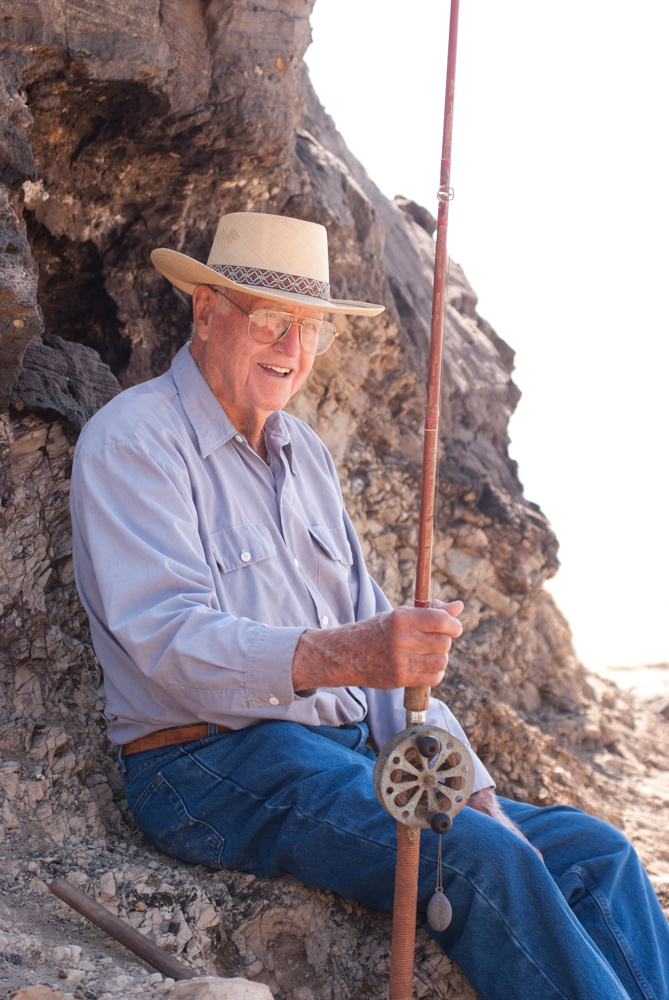
A boy runs barefoot, feet-toughened, through a winding maze of footpaths and weaves into a lemon orchard in Carpinteria, collecting sandstone pebbles of varying sizes to use as ammo for the slingshot in his back pocket. He aims at a rodent, a ground squirrel, pulls back the leather pad, and hits the creature squarely on its forehead.
This boy would grow up to be my grandfather, Lawrence Neil Bailard Jr., whom we called Lawry, Dad, Grand-père, Bumpa, Bompa, or Tío. He is no longer here to answer all our questions about ancestors or gopher eradication or some obscure historical fact about Dr. Seuss or Abraham Lincoln or the Matilija Fire. Lawry’s extraordinary life represented a vast storehouse of memory — the themes: the sea, the farm, and family.
Imagine little Lawry, sitting in the bucketed hull of a Flint skiff at age 3½; it’s his first trip to Santa Cruz Island. His dad pilots the small ship as the luxurious white Fleishman yacht passes, sending its wake-breaking waves into the small boat and making Lawry wonder if the vessel would fill with seawater and sink. This early exposure to adventuring on the Pacific Ocean led to a lifelong love affair with the Channel Islands.
A year later, Lawry watches one of the ranch’s massive oak trees sway and dip and touch the ground on two sides as a cataclysmic earthquake passes under and over Santa Barbara County. The early memory of this massive shift acted as the epicenter for his entire life. This land, covered with oak, avocado, and orange trees planted by his father, became the heart-center of his world.
Growing into himself, Lawry, now a young man, aims, fires, and kills his first deer in the backcountry. The deer is young, nearly too young to be legally hunted, but he feels the pride of the kill. Later he will confess to enjoying the company — friends and family and their stories and banter — not the killing. He flinched when it came time to pull the trigger on subsequent hunting trips.
He left Carpinteria to attend Stanford. Amid his fraternity brothers, Lawry found a communion and friendship that lasted a lifetime. At his 90th birthday, he sat for a photograph with five of them; by 2018, he’d survived them all.
Responding to the call to serve during World War II, Lawry enlisted. The year is 1943, and he has finished his U.S. Army Air Corps training in Wisconsin. The ship that will take him to Okinawa, Japan, waits behind him, but his blue eyes stare into the middle distance, where his mind focuses on his red-haired sweetheart, Kathryn. Lawry couldn’t keep his thoughts from Kay, and soon he asks her to marry him. Their wedding photo is black-and-white, but colors are not needed to record their radiance and joy.
The natural progression of Kay and Lawry’s essential bond was the birth of their children, Fred, Mary, Jim, and Dave. Lawry works constantly — long days of hoeing weeds, picking avocados, pulling hoses, and irrigating. Their mother warns the children that he needs a few hours of work in the mornings to turn his mood from sour to calm.
While it would have been easy to continue farming exactly as it had always been done, Lawry choses instead to grow pumpkins, creating Mr. Bailard’s u-pick pumpkin patch. It becomes so successful that the proceeds put all four children through college. The first crop was grown from seeds collected in Half Moon Bay, where the first Bailard ancestor, Old Original, had bought and sold a farm before moving to Carpinteria.
After the children grow up, Kay and Lawry travel the world, tourists in South America, Africa, and Europe, finding new boats, new harbors, new friends, and time for themselves, time that ended abruptly with Kay’s death in 2007.
As he aged into the 21st century, Lawry traveled in ever-decreasing circles. He met his second wife, Joan, and they created a loving picture of simple domestic pleasure that centered on Carpinteria. While their geographic travels decreased, their joined families multiplied: so many grandchildren, and great-grandchildren, so many photos of babies and cousins and friends and whales and ships.
A slingshot remained in Lawry’s possession his whole life. Very near the end, he asked my dad to stop at Federal Drug; he asked the pharmacist for two feet of medical tubing. “It’s for my slingshot,” he said. The pharmacist looked at Lawry wide-eyed. In his room at home, after he ended up in the hospital, my mother found the pieces of that slingshot arranged across his desk, a work in progress. A nurse reported he’d been working diligently on a plan to eradicate ground squirrels from an area near Rincon where he and Joan liked to sit and enjoy the view.
My grandfather was a man of few words, not given to speechifying, but we knew from his answers to all of our questions, from the way he chose his words, and from the way he delivered his wisdom, he loved us each and every one. As he lay dying, I finally worked up the courage to say something I’d wanted to say my whole life. I touched his shoulder and said quickly, “I love you.”
And in typical Bumpa fashion, he declared, “Likewise.”
